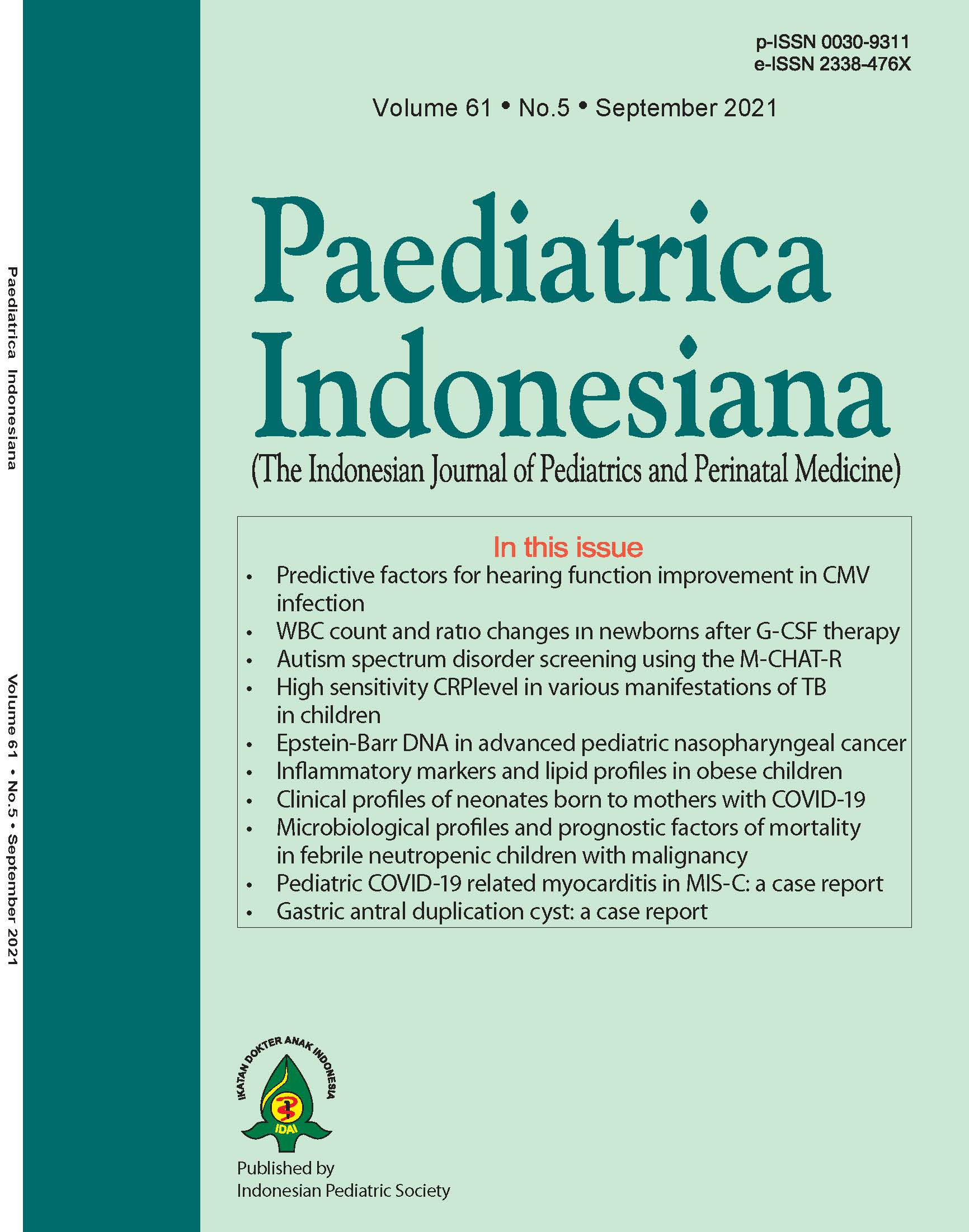White blood cell count and ratio changes in newborns after granulocyte colony-stimulating factor treatments
Abstract
Background Granulocyte-colony stimulating factor (G-CSF) is frequently used to treat neonatal neutropenia. There is a paucity of data in the literature on when immature to total neutrophil ratio (I/T ratio) can be accurately used as a sepsis marker after G-CSF therapy, as well as when I/T ratio returns to normal values expected in newborns who did not receive G-CSF.
Objective To investigate changes in white blood cells counts and ratios in neonates with neutropenia before and after G-CSF therapy.
Methods This retrospective study included newborns admitted to the NICU of Hacettepe University Ihsan Dogramaci Hospital, Ankara, Turkey, between 2005 and 2017 who received G-CSF therapy for neutropenia. Subjects underwent complete blood counts on the day before receiving G-CSF therapy (day 0) as well as days 1, 2, and 3 after treatment; I/T ratios were recorded from peripheral smears.
Results Twenty-eight neonates were included in the study. Subjects’ median gestational age (interquartile range 25–75%) was 32.6 (29.7–37.6) weeks, and median birth weight was 1,630 (1,040–2,980) g. On day 3, there were significant increases in white blood cell counts compared to day 0. There were statistically significant elevations in the I/T ratios between day 0 and day 1 and between day 0 and day 2. On day 3, the I/T ratio decreased, but was not significantly different between day 0 and day 3.
Conclusion The changes in I/T ratio observed after G-CSF treatments in our study suggest that the I/T ratio can be used as a reliable sepsis marker starting 72 hours after G-CSF administration. However, I/T ratio is significantly affected within 72 hours of G-CSF administration, and therefore, is unreliable as a sepsis marker during that period.
References
2. Funke A, Berner R, Traichel B, Schmeisser D, Leititis JU, Niemeyer CM. Frequency, natural course, and outcome of neonatal neutropenia. Pediatrics. 2000;106:45-51. DOI: 10.1542/peds.106.1.45.
3. Ognean ML, Boicean A, ?ular FL, Cucerea M. Complete blood count and differential in diagnosis of early onset neonatal sepsis. Rev Romana Med Lab. 2017;25:101-8. DOI: 10.1515/rrlm-2016-0042.
4. Christensen RD, Yoder BA, Baer VL, Snow GL, Butler A. Early-onset neutropenia in small-for-gestational-age ?nfants. Pediatrics. 2015;136:e1259-67. DOI: 10.1542/peds.2015-1638.
5. Christensen RD, Henry E, Wiedmeier SE, Stoddard RA, Lambert DK. Low blood neutrophil concentrations among extremely low birth weight neonates: data from a multihospital health-care system. J Perinatol. 2006;26:682-7. DOI: 10.1038/sj.jp.7211603.
6. Gabrilove JL, Jakubowski A. Hematopoietic growth factors: biology and clinical application. J Natl Cancer Inst Monogr. 1990;10:73-7. PMID: 1693284.
7. Lieschke GJ, Burgess AW. Granulocyte colony-stimulating factor and granulocyte-macrophage colony-stimulating factor. N Engl J Med. 1992;327:28-35. DOI: 10.1056/ NEJM199207023270106.
8. Lee JA, Sauer B, Tuminski W, Cheong J, Fitz-Henley J 2nd, Mayers M, et al. Best Pharmaceuticals for Children Act-Pediatric Trials Network Steering Committee. Effectiveness of granulocyte colony-stimulating factor in hospitalized ?nfants with neutropenia. Am J Perinatol. 2017;34:458-64. DOI: 10.1055/s-0036-1593349.
9. Castagnola E, Dufour C. Role of G-CSF GM-CSF in the management of infections in preterm newborns: an update. Early Hum Dev. 2014;90:S15-7. DOI: 10.1016/S0378-3782(14)50005-9.
10. Bilgin K, Yarami? A, Haspolat K, Ta? MA, Günbey S, Derman O. A randomized trial of granulocyte-macrophage colony-stimulating factor in neonates with sepsis and neutropenia. Pediatrics. 2001;107:36-41. DOI: 10.1542/peds.107.1.36.
11. Kuhn P, Messer J, Paupe A, Espagne S, Kacet N, Mouchnino G, et al. A multicenter, randomized, placebo-controlled trial of prophylactic recombinant granulocyte-colony stimulating factor in preterm neonates with neutropenia. J Pediatr. 2009;155:324-30.e1. DOI: 10.1016/j.jpeds.2009.03.019.
12. Akta? D, Demirel B, Gürsoy T, Oval? F. A randomized case-controlled study of recombinant human granulocyte colony stimulating factor for the treatment of sepsis in preterm neutropenic infants. Pediatr Neonatol. 2015;56:171-5. DOI: 10.1016/j.pedneo.2014.06.007.
13. Edwards MS. Clinical features, evaluation, and diagnosis of sepsis in term and late preterm infants. [cited YEAR MONTH DATE]. Available from https://www.uptodate.com/contents/clinical-features-evaluation-and-diagnosis-of-sepsis-in-term-and-late-preterm-infants.
14. Saboohi E, Saeed F, Khan RN, Khan MA. Immature to total neutrophil ratio as an early indicator of early neonatal sepsis. Pak J Med Sci. 2019;35:241-6. DOI: 10.12669/pjms.35.1.99.
15. Haque KN. Definitions of bloodstream infection in the newborn. Pediatr Crit Care Med. 2005;6:S45-9. DOI: 10.1097/01.PCC.0000161946.73305.0A.
16. Çelik HT, Portakal O, Yi?it ?, Hasçelik G, Korkmaz A, Yurdakok M. Efficacy of new leukocyte parameters versus serum C-reactive protein, procalcitonin, and interleukin-6 in the diagnosis of neonatal sepsis. Pediatr Int. 2016;58:119-25. DOI: 10.1111/ped.12754
17. Bell SG. Immunomodulation, part II: granulocyte colony-stimulating factors. Neonatal Netw. 2006;25:65-70. DOI: 10.1891/0730-0832.25.1.65.
18. Carr R, Modi N, Dorè CJ. G-CSF and GM-CSF for treating or preventing neonatal infections (Review). Cochrane Database Syst Rev. 2003;2003:CD003066. DOI: 10.1002/ 14651858.CD003066.
19. Bhat YR, Cherian CS. Neonatal thrombocytopenia associated with maternal pregnancy induced hypertension. Indian J Pediatr. 2008;75:571-3. DOI: 10.1007/s12098-008-0110-x.
20. Zuppa AA, Girlando P, Florio MG, Cota F, Romagnoli C, Tortorolo G. Influence of maternal preeclampsia on recombinant human granulocyte colony-stimulating factor effect in neutropenic neonates with suspected sepsis. Eur J Obstet Gynecol Reprod Biol. 2002;102:131-6. DOI: 10.1016/s0301-2115(01)00601-7.
21. Kücüködük S, Sezer T, Yildiran A, Albayrak D. Randomized, double-blinded, placebo-controlled trial of early administration of recombinant human granulocyte colony-stimulating factor to non-neutropenic preterm newborns between 33 and 36 weeks with presumed sepsis. Scand J Infect Dis. 2002;34:893-7. DOI: 10.1080/0036554021000026966.
Copyright (c) 2021 MELEK BUYUKEREN

This work is licensed under a Creative Commons Attribution-NonCommercial-ShareAlike 4.0 International License.
Authors who publish with this journal agree to the following terms:
Authors retain copyright and grant the journal right of first publication with the work simultaneously licensed under a Creative Commons Attribution License that allows others to share the work with an acknowledgement of the work's authorship and initial publication in this journal.
Authors are able to enter into separate, additional contractual arrangements for the non-exclusive distribution of the journal's published version of the work (e.g., post it to an institutional repository or publish it in a book), with an acknowledgement of its initial publication in this journal.
Accepted 2021-09-20
Published 2021-09-20













